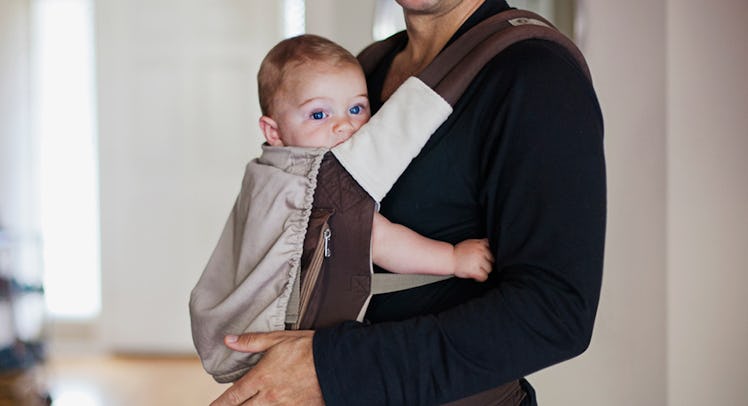5 Dangerous Baby Carrier Mistakes Parents Need to Avoid
Baby carriers are a great piece of gear for parents. But there are some dangerous mistakes parents need to avoid when strapping their babies to their chest.

A baby carrier is supposed to bring moms and dads closer to their child, but, as with most pieces of parenting gear, there are real dangers associated with them that parents need to be aware of. For instance, in 2018, Australian doctors issued an alert to parents after three South African babies died due to ill-fitting carriers. The danger, of course, is not limited to abroad; the U.S. Consumer Product Safety Commission found 159 incidents with improperly fitting slings, which included 17 deaths over a 14-year period. Of course, accidentally death is not the only issue. An improperly positioned baby carrier or sling can also lead to issues with a baby’s arms or hips, too.
“It’s always best that you use your family doctor as a reliable source whenever you’re discussing anything regarding baby carriage,” says Dr. Robert Raspa, a pediatrician in Jacksonville, Fla., and member of the American Academy of Family Physicians. With more than 37 years in the field, Dr. Raspa has seen his share of ill-fitting carriers. If a parent keeps in mind a few points, he says, the risk is dramatically reduced.
First and foremost, Raspa says, when in a carrier, a baby’s face should never be pressed up against chest or back. They should be allowed to look up, down, and forward. The hips and knees should be bent, and the arms able to move around. For infants still developing neck muscles, a head support is recommended.
When it comes to slings, a properly fitting unit, per Raspa, allows room for a child to move his or her head. Arms should be in a flexed position, with the shoulders down and elbows up. The knees should also be up, \allowing for some movement side to side. Every limb, he says, should be able to move a bit.
Baby Carrier Danger #1: Putting a Baby in a “C-Shape”
The first consideration for proper fit, per Raspa, is to ensure the child isn’t forced chin-to-chest, which doesn’t allow him or her to straighten out. In such a position, there’s a risk of cutting off the airway. “Anything that would keep the baby from breathing,” he says, should be avoided. When carrying, notice any squirming while visually assessing for your child changing colors. Both, he says, are clear warning signs. You want your child to have room to lengthen.
Baby Carrier Danger #2: Strapping a Baby in Too Tightly
While your child can be forced into a position where he or she can’t breathe, being held too tightly to you can also pose risks. Once you’ve ensured that your child isn’t forced into a C-shape, check to see that he or she isn’t being forced into your chest or back, which can also pose a risk for suffocation. The same warning signs from the previous point apply.
Baby Carrier Danger #3: Not Accounting For Temperature
When the summer sun is out, provided you’ve got a well fitting sling, your baby should be fine: “Babies can raise their core body temperatures quite a bit. A degree or two is not an issue,” Dr. Raspa says. Of course, freedom of movement and a clear airway are key. However, if a baby is sweating excessively or turning red, it’s time to remove your child and get him or her into the shade to cool down.
Baby Carrier Danger #4: Letting a Baby’s Legs Hang Straight
“We want the baby’s hips to stay in a position up close to their bellies in a ‘W’ kind of situation,” Dr. Raspa says referencing the natural splay open from the groin when a child’s knees are drawn up. While it may seem counterintuitive, you actually want the child’s butt pulled toward the belly, with the legs bent and naturally falling open. If his or her legs hang straight down, your child is at risk for hip dysplasia, which is a deforming of the socket joint, to which those less than six months are especially prone. Find a carrier with a wide base or ensure your wrap sits wide over the bottom and extends to the backs of the knees. For reference, find a chart here.
Baby Carrier Danger #5: Ignoring Straight Arms
A baby’s arms, Dr. Raspa says, shouldn’t be stuck out to the side. If they are, your child is at risk for shoulder dislocation. Do a quick visual check: Do his or her arms have a gentle bend to them? You’re all set. It’s only when a limb is forced straight that the risk is present.
This article was originally published on